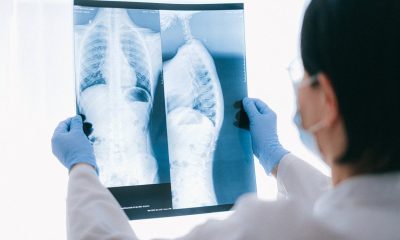Scientists say if this happens when you stand up you’re at risk of having a stroke or heart attack
Published
2 years ago onBy
Talker News
By Gwyn Wright via SWNS
A big rise in blood pressure when you stand up could mean you are at risk from a stroke or heart attack, according to scientists.
Young and middle-aged people whose blood pressure jumped most quickly were almost twice as likely to experience a heart attack, stroke or another major cardiovascular event later in life.
The sudden jump could become an easy test to identify who is most at risk and the discovery could mean pressure-busting medicines could start being used earlier.
High blood pressure affects around a third of Brits although many do not realize it, according to the NHS website.
It affects around two in five people globally and is considered to be the world’s leading preventable cause of death.
Statistics suggest people with high blood pressure, known as hypertension, in middle age are five times more likely to have brain cognitive impairment and are twice as likely to end up with dementia or Alzheimer’s disease when they get older.
Typically, systolic blood pressure falls slightly when you stand up, which sparked the researchers' curiosity into whether the opposite response means people are at higher risk of cardiac arrest and stroke.
For the study, the researchers looked at records of 1,207 Italians who took part in the HARVEST study, which began in 1990.
Participants were between 18 and 45 years old with untreated stage one hypertension- which is systolic pressure of between 140 and 159 millimeters of mercury (mmHg) or a diastolic pressure of 90 to 100 mmHg.
None of them had taken blood pressure-lowering medication before they took part in the study and they were all initially deemed to be at low risk of heart attack and stroke.
They did not have diabetes, kidney impairment or any other cardiovascular diseases.
When they enrolled in the study, participants were an average age of 33, 72 percent were men and they all were white.
When they enrolled, six blood pressure measurements for each participant were taken in various physical positions, including when they were lying down and after standing up.
The 120 participants with the highest rise (top 10 percent) in blood pressure upon standing averaged an 11.4 mm/Hg increase and all increases in this group were greater than 6.5 mm/Hg.
The remaining participants averaged a 3.8 mm/Hg fall in systolic blood pressure upon standing.
The researchers compared heart disease risk factors, laboratory measures and the occurrence of major cardiovascular events including heart attack, heart-related chest pain, stroke, aneurysm of the aortic artery, clogged peripheral arteries and chronic kidney disease among participants in the two groups.
In some cases, the development of atrial fibrillation, an arrhythmia that is a major risk factor for stroke, was also assessed.
Results were adjusted for age, gender, parental history of heart disease, and several lifestyle factors and measurements taken during study enrolment.
During the follow-up period, which averaged 17 years, 105 major cardiovascular events took place.
The most common were heart attack, heart-related chest pain and stroke.
The 10 percent of participants with the fastest rise in blood pressure were almost twice as likely as others to experience a major cardiovascular event.
They did not have a higher risk from major heart scares when they were first examined, apart from their exaggerated response to standing.
People in this group were also more likely to be smokers but were no heavier or lazier than other participants.
They were also no more likely to have a family history of heart problems.
In fact, their cholesterol levels were lower than for other participants and they had lower blood pressure levels when they were lying down.
After adjusting for average blood pressure taken over 24 hours, a heightened blood pressure response to standing remained an independent predictor of adverse heart events or stroke.
Lead study author Professor Paolo Palatini said: “The results of the study confirmed our initial hypothesis - a pronounced increase in blood pressure from lying to standing could be prognostically important in young people with high blood pressure.
“We were rather surprised that even a relatively small increase in standing blood pressure was predictive of major cardiac events in the long run.
“This finding may warrant starting blood-pressure-lowering treatment including medicines earlier in patients with exaggerated blood pressure response to standing.”
In a subset of 630 participants who had stress hormones measured from 24-hour urine samples, the epinephrine/creatinine ratio was higher in the people with a rise in standing blood pressure compared to those whose standing blood pressure did not rise.
Epinephrine levels are an estimate of the effect of stressful stimuli over the 24 hours.
This suggest the people who had the highest blood pressure when they stood up may have more of a fight-or-flight response to stressors, which causes a rise in blood pressure.
Professor Palatini suggests the findings suggest blood pressure on standing should be measured so the right treatment can be tailored to people at higher risk.
He says people with the highest pressure may need pressure-lowering therapy and need do more to cut down on unhealthy habits.
Professor Palatini said: “Epinephrine levels are an estimate of the global effect of stressful stimuli over the 24 hours.
“This suggests those with the highest blood pressure when standing may have an increased sympathetic response [the fight-or-flight response] to stressors.
“Overall, this causes an increase in average blood pressure.
“The findings suggest that blood pressure upon standing should be measured in order to tailor treatment for patients with high blood pressure, and potentially, a more aggressive approach to lifestyle changes and blood-pressure-lowering therapy may be considered for people with an elevated [hyperreactor] blood pressure response to standing.”
The findings were published in the American Heart Association’s journal Hypertension.
Stories and infographics by ‘Talker Research’ are available to download & ready to use. Stories and videos by ‘Talker News’ are managed by SWNS. To license content for editorial or commercial use and to see the full scope of SWNS content, please email [email protected] or submit an inquiry via our contact form.
You may like


How blood samples will be able to tell whether cancer patients will survive


Stroke deaths rising after plummeting for 40 years


New artificial pancreas could help Type 2 diabetes patients


How algae can help wounds heal quicker


Antibiotic residue in wastewater contributing to dangerous resistance


Warming oceans decimated sea parasites to damage environment
Other Stories


Scientists create family tree of coffee for clues to resist climate change
Researchers traced Arabica coffee back to the forests of Ethiopia.


Fool’s gold could be valuable source of lithium: study
By Imogen Howse via SWNS Fool's gold could be valuable after all as a new source of lithium, crucial to...


Giant kangaroos twice the size of today’s once hopped across Australia
The species lived from around five million to 40,000 years ago.


Scientists solve mystery of which giant roamed these British waters
No one could work out what animal group the 200 million-year-old giant bones belonged to.


Tiny ingestible beads could help fight liver disease: study
The newly invented beads smaller than a grain of salt reduce bad bacteria and inflammation.
Top Talkers

 Dating & Relationships1 week ago
Dating & Relationships1 week agoStudy says couples who drink together live longer

 Food & Drink6 days ago
Food & Drink6 days agoWe eat enough grilled cheeses a year to fill 900 Olympic swimming pools

 Broadcast6 days ago
Broadcast6 days agoOver 50% of Americans trust Google more than their schooling

 Animals7 days ago
Animals7 days agoAdorable Australian is a 4-year-old ‘wombat whisperer’

 Broadcast6 days ago
Broadcast6 days agoAmericans eat enough grilled cheeses a year to fill 900 Olympic swimming pools

 Broadcast5 days ago
Broadcast5 days agoGrocery shopping hungry is costing Americans this much
- Broadcast7 days ago
Why 3 in 4 prefer road trips over flying

 Funny5 days ago
Funny5 days agoCops confused by crow mimicking police siren
